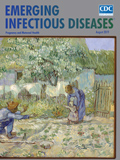
Volume 25, Number 8—August 2019
Research Letter
Feast of Sacrifice and Orf, Milan, Italy, 2015–2018
On This Page
Tables
Downloads
Article Metrics
Abstract
Orf (ecthyma contagiosum) is an infection of the skin caused by a DNA virus belonging to the genus Parapoxvirus. We recently observed 7 cases of orf in Muslim men living in the metropolitan area of Milan, Italy, who acquired the infection after the Feast of Sacrifice.
Orf (ecthyma contagiosum) is an infection of the skin caused by a DNA virus of the genus Parapoxvirus, family Poxviridae. Skin lesions (e.g., vesicles, blisters, pustules, erosions, ulcers, papules, nodules) occur at sites of inoculation of the virus 3–15 days after infection. Hands are usually affected (1). The differential diagnosis for orf includes milker’s nodule, anthrax, tularemia, fish tank granuloma, cutaneous leishmaniasis, pyogenic granuloma, and keratoacanthoma (1). The disease spontaneously heals within 6 weeks, although pain, bacterial superinfections, and regional lymphadenitis are possible (1). Treatment is based on topical antiseptics (1).
Orf virus usually infects sheep and goats. Humans are infected by handling infected meat from these animals; orf is considered an occupational disease in shepherds, shearers, veterinarians, butchers, and cooks (1). In the last few years, orf has occurred after the Muslim Feast of Sacrifice (Eid al-Adha) (1–10). In 2014, we reported a case of orf that appeared after sheep slaughtering for this feast (1). During 2015–2018, we observed 7 additional cases in Muslim men 18–61 years of age who were of Moroccan, Tunisian, or Egyptian origin. They had been infected 2–3 weeks after lamb slaughtering for the feast (Table). One patient was a butcher. In all patients, 1 hand and/or fingers were involved. In 4 patients, orf presented with erythematous pustules; 3 of these patients had ulcerated nodules. In all patients, clinical diagnosis was confirmed by histopathologic examinations.
Orf acquired during the Feast of Sacrifice was reported in 1982 in Turkey (2). Other cases were subsequently reported in France (3,10), Belgium (4,5), Italy (1), Turkey (6,7,9), and the United States (8). Epidemics also were reported: in Belgium, 23 cases in 2000 and 44 cases in 2001 (4,5), and in Turkey, 9 cases in 2005 and 29 cases in 2009 (6,7).
In most reported cases, orf appeared days or weeks after the Feast of Sacrifice. This feast is celebrated 2 months and 10 days after the end of Ramadan; the exact date varies (4). During the feast, many Muslim families kill a lamb, which has to be bled alive (4). Only men may kill the lamb. Orf occurs more often in men; however, it occurs also in women, who often handle the infected meat with bare hands during preparation and cooking.
In conclusion, in the metropolitan area of Milan, where ≈250,000 Muslims reside, we recently observed 7 patients with orf acquired during the Feast of Sacrifice. Prevention measures are difficult. For example, most of the Muslims living in the metropolitan area of Milan are Moroccans, who travel to Italy by car, carrying the infected meat; thus, no prevention measures have been taken.
Dr. Veraldi is a dermatologist and venereologist at the Dermatology Unit and head of the Postgraduate School of Dermatology and Venereology at the University of Milan. His primary research interests are infectious and parasitic diseases of the skin.
References
- Veraldi S, Nazzaro G, Vaira F, Çuka E. Presentation of orf (ecthyma contagiosum) after sheep slaughtering for religious feasts.Infection. 2014;42:767–9.
- Günes AT, Gezen C, Kapdağhi H, Marschall HJ. [Ecthyma contagiosum epidemics in Turkey] [in German]. Hautarzt. 1982;33:384–7.
- Guibal F, Cosnes A, Wechsler J, Miseri E, Revuz J, Chosidow O. Religious ritual practices as a contamination mode of human orf. Eur J Dermatol. 1996;6:41–2.
- Ghislain PD, Dinet Y, Delescluse J. Orf contamination may occur during religious events. J Am Acad Dermatol. 2000;42:848.
- Ghislain PD, Dinet Y, Delescluse J. [Orf in urban surroundings and religious practices: a study over a 3-year period] [in French]. Ann Dermatol Venereol. 2001;128:889–92.
- Uzel M, Sasmaz S, Bakaris S, Cetinus E, Bilgic E, Karaoguz A, et al. A viral infection of the hand commonly seen after the feast of sacrifice: human orf (orf of the hand). Epidemiol Infect. 2005;133:653–7.
- Gündüz K, Inanir I, Sacar T. Orf and religious practices. J Dermatol. 2005;32:306–8.
- Malik M, Bharier M, Tahan S, Robinson-Bostom L. Orf acquired during religious observance. Arch Dermatol. 2009;145:606–8.
- Sasmaz S, Uzel M, Sener S, Ucmak H. Rare presentation of human orf as multiple lesions. J Dermatol. 2011;38:825–6.
- Nougairede A, Fossati C, Salez N, Cohen-Bacrie S, Ninove L, Michel F, et al. Sheep-to-human transmission of Orf virus during Eid al-Adha religious practices, France. Emerg Infect Dis. 2013;19:102–5.
Table
Cite This ArticleOriginal Publication Date: 6/25/2019






















.png)











No hay comentarios:
Publicar un comentario